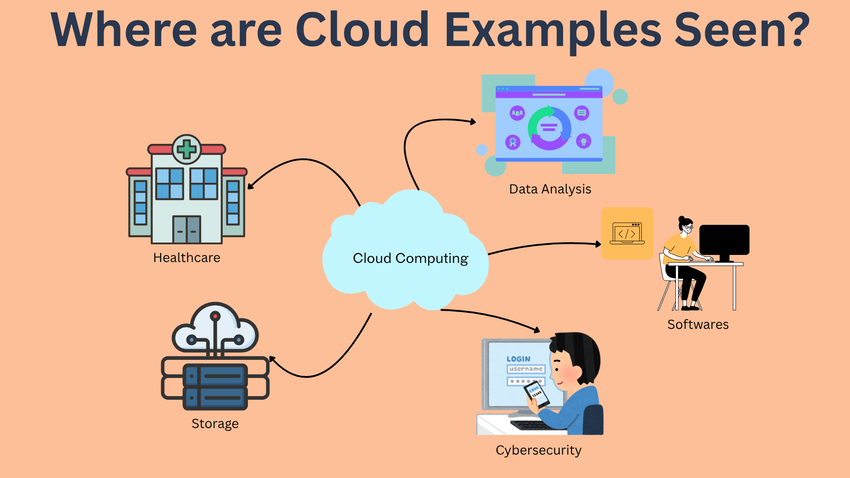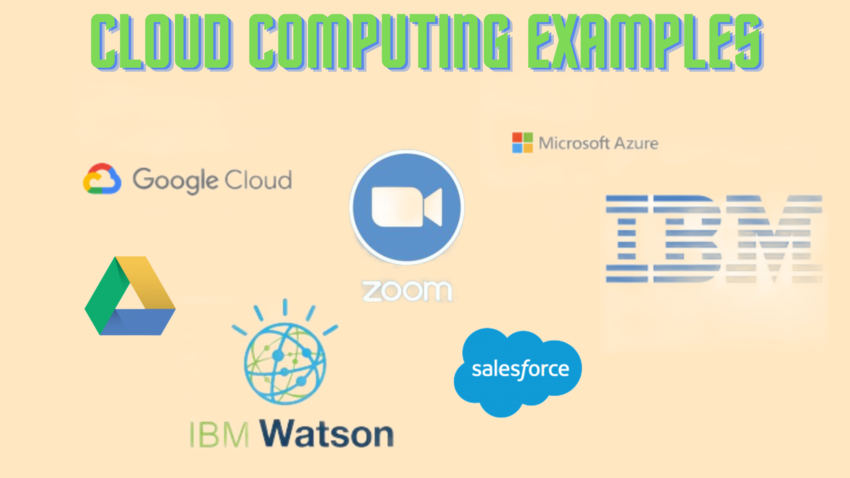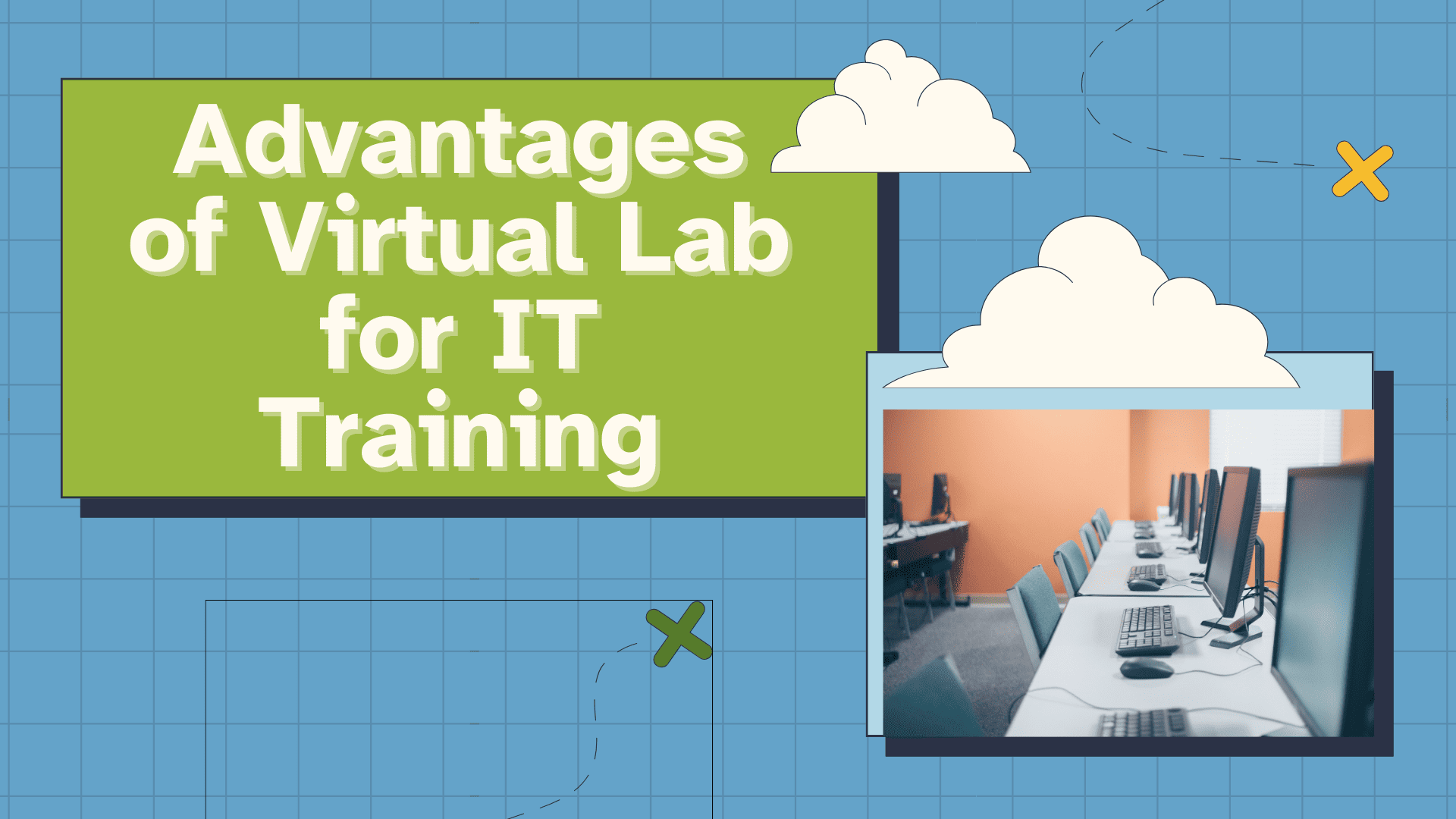
Cloud computing has become integral to our daily lives, transforming how we communicate, work, and access information. From streaming services like Netflix to collaborative tools such as Google Docs, we are surrounded by cloud computing examples.
In this article, we have provided the top 24 examples of cloud computing in real life. You must be using most of these cloud examples in your everyday life. We have tried to include examples from different industries like entertainment, business, education, healthcare, etc.
Furthermore, if you are interested in making a career in cloud computing, you should check out our Cloud Computing courses, where we provide certification training for Google Cloud, AWS, and Azure.
What is Cloud Computing?
Cloud computing is a technology that allows computing services like servers, storage, databases, networking, software, and analytics to be used over the internet (“the cloud”). Users can access and store data remotely, reducing the need for physical hardware.
Cloud computing is gaining popularity due to its flexibility, scalability, and cost-efficiency, making it ideal for businesses and individuals. Cloud services are categorized in cloud models, including Infrastructure as a Service (IaaS), Platform as a Service (PaaS), and Software as a Service (SaaS).

Example of Cloud Computing in Different Services
Since cloud computing provides different services like storage, infrastructure, software, etc, we have provided examples for each service. The table below shows 24 examples of cloud technology based on the type of service.
| Type of Service | Example |
|---|---|
| Cloud Infrastructure Examples | Amazon Web Services (AWS) |
| Microsoft Azure | |
| Google Cloud Platform (GCP) | |
| Cloud Platform Examples | Heroku |
| Google App Engine | |
| Microsoft Azure App Service | |
| Cloud Software Examples | Google Workspace |
| Microsoft 365 | |
| Salesforce | |
| Cloud Storage Examples | Dropbox |
| Google Drive | |
| Amazon S3 | |
| Cloud Backup and Recovery Examples | Backblaze |
| Acronis | |
| Carbonite | |
| Cloud Hosting Examples | DigitalOcean |
| Linode | |
| Vultr | |
| Cloud Collaboration Tools Examples | GitHub |
| Slack | |
| Trello | |
| Cloud AI & ML Examples | AWS SageMaker |
| Google AI Platform | |
| IBM Watson |

Cloud Software Examples
Software as a Service (SaaS) is a cloud computing model that delivers applications over the Internet, allowing users to access software without installation. Top examples of cloud software are:
1. Microsoft 365
It is a cloud-based suite of productivity tools and includes applications such as Word, Excel, PowerPoint, Outlook, and Teams. It allows users to collaborate in real time, store documents in the cloud (OneDrive), and access them from anywhere on any device.
Businesses and individuals use Microsoft 365 for day-to-day tasks like document creation, email communication, virtual meetings, and file sharing. The cloud-based nature allows teams to collaborate regardless of location.
2. Slack
It is a messaging platform that facilitates team communication through channels, direct messaging, and integration with other software. Slack is fully hosted in the cloud and is a popular tool for remote teams.
Companies with the WFH model might use Slack to streamline internal communications, organize project discussions into specific channels, and integrate with other apps like Google Drive or Jira for a seamless workflow.
3. Zoom
It is a cloud-based video conferencing platform that allows users to hold virtual meetings, webinars, and online collaboration sessions. It offers screen sharing, recording, and breakout rooms for smaller group discussions.
During the COVID-19 pandemic, businesses, educators, and individuals used Zoom for virtual meetings, remote work, online classes, and conferences. The cloud infrastructure of Zoom allows it to scale quickly to handle millions of users globally.
Cloud Infrastructure Service Examples
Infrastructure as a Service (IaaS) is a cloud computing model that provides virtualized computing resources like servers, storage, and networking on a pay-as-you-go basis over the Internet. Some popular examples of such Cloud Service Providers are:
4. Google Cloud Platform (GCP)
● Google Cloud Platform is a suite of cloud computing services that offer scalable infrastructure for running applications, storing data, and deploying machine learning models, etc.
Big to small enterprises use GCP for hosting their websites, processing large-scale data analytics, and running machine learning applications. It’s also used for managing high-traffic workloads with automatic scaling.
5. Amazon Web Services (AWS)
Amazon Web Services is one of the most comprehensive cloud infrastructure providers. It offers computing power, storage, and networking resources on demand. Popular services offered by AWS include EC2 (Elastic Compute Cloud), S3 (Simple Storage Service), and Lambda (serverless computing).
Companies use AWS to host their infrastructure, including web servers, databases, and big data analysis. It is also widely used for disaster recovery, content delivery, and data storage.
6. IBM Cloud
It is a cloud platform that offers virtual machines, storage, networking, and AI-powered services. It supports both public and private cloud environments, making it ideal for hybrid cloud strategies.
IBM Cloud is used by enterprises for deploying mission-critical applications, AI models, and blockchain technologies, especially in sectors like healthcare and finance, where security is critical.
Cloud Platform Service Examples
Platform as a Service (PaaS) is a cloud computing model that provides a framework for developers to build, deploy, and manage applications without worrying about underlying infrastructure. Some popular examples of cloud computing in PaaS include:
7. Google App Engine
It is a fully managed platform that allows developers to build and deploy applications without worrying about underlying infrastructure like servers, storage, or networking. It supports programming languages like Python, Java, and Node.js.
Startups and developers use Google App Engine to build and deploy scalable web apps and mobile backends without the overhead of managing physical servers.
8. Microsoft Azure App Services
It is a platform for building, deploying, and scaling web apps and APIs in the cloud. Azure App Services handles everything from security patches to auto-scaling and integrates with other Azure services like databases and AI tools.
Companies use Azure App Services to build and scale enterprise-level web applications, ensuring high availability and security without the need for complex infrastructure management.
9. Heroku
It is a cloud platform that allows developers to build, run, and operate applications entirely in the cloud. Heroku focuses on ease of use, supporting a range of programming languages and offering a marketplace of add-ons for databases, monitoring, and more.
Small to medium businesses and developers use Heroku to deploy web applications quickly and scale them based on user demand without worrying about infrastructure management.
Cloud Storage Examples
Cloud storage is one of the most commonly used cloud services. Many platforms use cloud computing to provide secure access to documents, photos, and videos from any device. Some most popular examples of cloud storage services are:
10. Google Drive
It is a cloud-based storage service that allows users to store files, share them with others, and collaborate on documents in real-time. You must have seen it if you use Android phones. Google Drive stores files from other Google services like Docs, Sheets, and Slides.
Businesses and individuals use Google Drive to store and share documents, spreadsheets, and presentations, with real-time collaboration for teams.
11. OneDrive (Microsoft)
It is a cloud storage service provided by Microsoft that integrates with Microsoft 365 applications. It allows users to store, share, and synchronize files across multiple devices. If you use the Microsoft Windows OS on your PC, you must have seen OneDrive, as it stores your computer backup.
Users of Microsoft Office apps store and share files using OneDrive, accessing them from any device, and collaborating on documents with team members.
12. Box
It is a cloud content management and file-sharing platform designed for businesses, particularly large enterprises. It provides advanced security, compliance, and administrative controls over document access and sharing.
Enterprises use Box to manage and securely share sensitive documents across departments, collaborate on projects, and integrate with enterprise software like Salesforce and Microsoft 365.
Cloud Data Analysis Service Examples
Big Data analysis in cloud computing has transformed how organizations process and extract insights from vast amounts of data. Instead of using heavy data-analysis software, people can use cloud services that let them do the high computational data analysis even on a low-end computer. Some examples of cloud-based data analysis services are:
13. Cloudera
It is an enterprise data cloud platform that provides tools for managing and analyzing large volumes of data. It offers services like data warehousing, machine learning, and real-time analytics.
Organizations in industries like healthcare, finance, and manufacturing use Cloudera to analyze large datasets for insights that drive decision-making, predictive modeling, and business optimization.
14. Google BigQuery
It is a fully managed and serverless data warehouse designed for big data analytics. BigQuery allows organizations to analyze petabytes of data using SQL queries with no need for infrastructure management.
Companies use BigQuery for real-time data analysis, machine learning, and reporting on large datasets, enabling faster decision-making.
15. Apache Hadoop
It is an open-source framework for distributed storage and processing of large datasets. Hadoop uses a network of computers to store and process data, making it highly scalable and efficient for big data workloads.
Organizations use Hadoop for managing massive amounts of data, including structured and unstructured data, for tasks like data mining, machine learning, and predictive analytics.
Cloud Cyber Security Platform Examples
Cloud computing has penetrated the cyber security industry, and now companies are developing cloud-based cyber security solutions like firewalls. This helps in reducing the cost of purchasing hardware for network security. Some examples of cloud-based cyber security solutions are:
16. CrowdStrike Falcon
It is a cloud-native endpoint protection platform that uses AI and behavioral analytics to detect and prevent cyber threats in real time.
Businesses use Falcon to monitor devices across their network, detect malware, and respond to threats instantly without needing on-premise infrastructure.
17. Tenable Cloud Security
It is a cloud security solution that provides visibility into cloud risks, misconfigurations, and identity permissions across AWS, Azure, and GCP.
Enterprises use Tenable to continuously assess cloud environments, prioritize vulnerabilities, and ensure compliance with security standards.
18. Google Cloud Security
Google Cloud security is a suite of security tools and services integrated into Google Cloud Platform, offering identity management, data protection, and threat detection. It is responsible for securing all of Google Cloud services.
Organizations use Google Cloud Security to secure workloads, manage access controls, and protect sensitive data across cloud applications.

Cloud Healthcare Platform Examples
Even healthcare services have started to use cloud computing for diagnosing diseases or maintaining the medical records of patients. Some examples of cloud services being used in healthcare are:
19. IBM Watson Health
It is a cloud-based AI platform that helps healthcare providers analyze large volumes of medical data to improve diagnosis, treatment planning, and patient outcomes.
Hospitals use Watson Health to assist in cancer diagnosis by analyzing patient records, medical literature, and clinical trial data to recommend personalized treatment options.
20. Philips HealthSuite
It is a cloud-based platform designed to collect, store, and analyze health data from various sources, including wearable devices, EMRs, and imaging systems.
Healthcare providers use HealthSuite to monitor patients remotely, manage chronic conditions, and integrate data from multiple devices for better clinical decisions.
21. Cerner Health Cloud
It is a cloud-based health information technology solution that enables secure data sharing, population health management, and analytics.
Clinics and hospitals use Cerner to streamline patient records, improve care coordination, and analyze health trends across populations for preventive care.
Cloud Computing Examples in Education Sector
Cloud computing has transformed the education sector by enabling flexible, scalable, and cost-effective learning environments. It has helped institutions to deliver online courses, manage student data, collaborate in real time, and provide access to educational resources from anywhere. Some popular examples of cloud platforms in EdTech. sectors are:
22. Google Classroom
It is a cloud-based learning management system (LMS) that helps teachers create, distribute, and grade assignments in a paperless way. During the COVID-19 pandemic, schools and universities adopted Google Classroom to assign homework and grade assignments. It is also used to manage virtual classrooms, share resources, conduct quizzes, and communicate with students in real time.
23. Microsoft Azure for Education
It is also a cloud platform offering tools and services for educational institutions, including virtual labs, AI tools, and scalable infrastructure.
Many universities use Azure to host online courses, run simulations, and provide students with access to virtual machines for coding and research.
24. Coursera
Coursera might not appear to be a cloud service, but it is a cloud-based e-learning platform that partners with universities and organizations to offer online courses, certificates, and degrees.
Students and professionals use Coursera to access high-quality educational content from anywhere, enabling flexible and remote learning.
Conclusion
In summary, cloud computing has transformed how businesses operate by offering flexible, scalable, and cost-effective solutions across various domains.
From SaaS tools like Salesforce and Microsoft 365 to IaaS providers like AWS and DigitalOcean, and PaaS platforms like Google App Engine, the cloud simplifies infrastructure, software deployment, and data management.
Additionally, services for file storage (Dropbox), big data analysis (Civis Analytics), data governance (Carbonite), and cybersecurity (Forcepoint) enhance business operations and security. Cloud technology is becoming indispensable across industries, driving innovation and efficiency.
Understanding different cloud computing examples will help you understand the dependencies of cloud technology and how we are surrounded by cloud applications.

Amar Singh is a senior security architect and a certified trainer. He is currently working with a reputed organization based out of India. His accomplishments include CCNA, CCNP Security, CEH, Vmware, Checkpoint and Palo Alto Certifications. He is holding more than 12 years of experience in Network security domain. In his career he has been ...
More... | Author`s Bog | Book a MeetingFAQ
Comments (0)
Popular posts


Different Types of Network Topologies ...
25 Aug 2025
CCNA Exam Fees and Expenses Breakdown
25 Aug 2025
New Cisco CCNA Syllabus for 2025
25 Aug 2025
Top 12 Cloud Service Providers Globally ...
29 Aug 2025Recent posts

10 Advantages of Virtual Labs for ...
12 Sep 2025
Common TCP Ports and Their Applications
11 Sep 2025
Expert Tips to Pass the F5 101 ...
10 Sep 2025
What is VRF? Full-Form, Uses and ...
10 Sep 2025
What is OSPF Protocol in Networking?
10 Sep 2025Upcoming batches
Contact learning advisor










